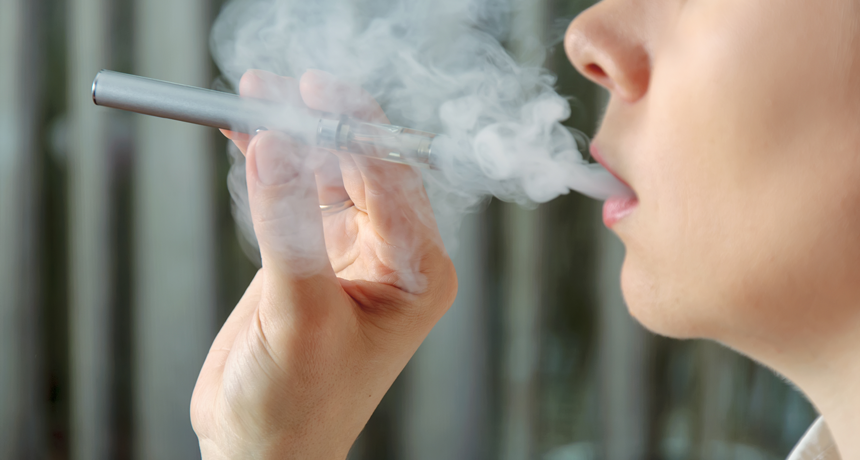Vaping may put your smile at risk
New cell study shows e-cigarette vapors damage cells of the mouth

E-cigarette vapors are not benign. They can damage cells in the mouth, threatening the health of gums and teeth, a new study finds.
AlexShalamov/iStockphoto
Here’s news that could put a frown on your face. New data show that electronic cigarettes pose a threat to cells in the mouth — and ultimately a vaper’s smile.
Electronic-cigarette use, or vaping, among teens is on the rise. The number of kids that tried vaping quadrupled between 2013 and 2015. In the United States, more kids now vape than smoke tobacco cigarettes. Ads on TV and the internet show e-cigarettes as being safe and fun. However, scientists have been turning up evidence that vaping is not harmless. And now researchers have found that e-cigarette vapors can pose risks to the gums and teeth.
Irfan Rahman works at the University of Rochester in New York. This biochemist studies the potential harm posed by-products and pollutants, including e-cigs. Last year, Rahman told Science News that many teens and young adults said vaping made their throats dry and scratchy. Some told his group that vaping made them cough and their mouths bleed. “We’ve got to start looking into these things and see what’s going on,” Rahman concluded.
E-cigarettes are battery-operated devices. A metal coil inside the device gets very hot. When a flavored liquid passes over these coils, it vaporizes into a gas that users breathe in. E-liquids contain mixtures of chemicals that produce different flavors. Most mixes contain some nicotine, too. (Nicotine is the addictive substance that gives cigarettes their “buzz.”) The liquids tend to be labeled as food grade, which means they are safe enough to eat. But heating these liquids can change their chemical composition. Experts say these chemical changes can make the vapors more toxic — more harmful — than the e-liquids themselves.

His team has now started to do just that.
The researchers have begun to probe what e-cig vapors do to cells of the mouth. They started by growing different types of human mouth cells in the lab. They looked at cells that make up the gums. They also looked at ligament cells that attach teeth to the gums. They exposed each type of cells to the chemicals from e-cigarette vapors.
Those vapors can alter the DNA in these cells, the scientists found. Exposing the cells to e-cig vapors damaged their DNA. DNA damage can change the genetic instructions that tell a cell how to grow and function. Over time, such changes might trigger the development of cancer. The vapors also can harm the cells by causing sustained inflammation.
Taken together, these changes point to a risk of cancer, gum disease and possibly tooth loss for anyone using e-cigarettes. Rahman’s team described its new findings in a paper published October 24 in the journal Oncotarget.
Inflammation — a chemical ‘red flag’ of danger
Mouth cells exposed to e-cigarette vapors gave off warning signals known as inflammatory markers. These markers signal that a process called inflammation is underway. Flavored e-cigs caused more of these inflammatory markers and signs of DNA damage to appear than did unflavored e-cig vapors. Because these flavor chemicals are not present in regular cigarettes, Rahman calls this finding especially worrisome. Indeed, he says, the flavored vapors may pose cellular risks that are unique to e-cigarettes.
Overall, Rahman saw lower levels of inflammation in cells treated with e-cig vapors than would be expected from treating cells with smoke from tobacco cigarettes. Still, that doesn’t mean e-cigs are safer than regular cigarettes, Rahman cautions, because researchers still don’t know what the long-term health effects of e-cig use might be.
Inflammatory markers are chemicals that “tell our bodies that something is going wrong. They send signals that these cells have been damaged,” explains Maciej Goniewicz. He’s a toxicologist at the Roswell Park Cancer Institute in Buffalo, N.Y. Like Rahman, he studies the health effects of e-cigarette vapors. Goniewicz was not involved in the new research on mouth cells.
Inflammation can be helpful. It helps turn on the body’s immune system. This allows it to fight off foreign invaders that don’t belong in the body, such as bacteria and viruses. Inflammation also can help the body heal itself after an injury.
But chronic inflammation, the type that doesn’t go away, is not good. And chronic inflammation is what Rahman and his colleagues worry might occur in a vaper’s mouth. Long-term inflammation of the gums can cause disease. Gum disease can destroy the tissue and bone that hold teeth in place. Severe gum disease even can lead to tooth loss.
The new research corroborates a study Goniewicz published earlier this fall. The bronchial (BRON-kee-ul) tubes are airways that lead to the lungs. Flavored e-cigarette vapors caused similar signs of inflammation to bronchial tube cells as Rahman’s group now reports in mouth cells. The e-cig vapors caused less damage to the bronchial cells than tobacco smoke did. Still, Goniewicz emphasizes, “We are seeing that the e-cigarettes do some harm to cells.”
Looking for the big picture
Fawad Javed is a dentist at the University of Rochester. Studying cells in the lab are important for several reasons, he says. “If somebody that smokes or vapes comes to me with oral disease, I need to understand why this is happening.” Javed worked with Rahman on the new study. Seeing changes on the chemical level can point dentists to the root cause of disease, he argues. And once that’s known, he explains, heath professionals can begin to figure out how to prevent disease.

In the lab, scientists can control and manipulate growing conditions. This allows them to scout for specific effects. Still, the scientists know there are many more things at play in the body than can be probed with dishes of cells in some laboratory. To get the full picture of what the new research means for oral health, scientists will have to combine what they learn in cell studies with data from human vapers.
Rahman and Javed have begun doing just that. They have started collecting samples from the mouths of vapers. Called gingival (JIN-jih-vul) crevicular (Kreh-VIC-u-ler) fluid, this watery substance comes from the tiny pockets between the gums and the teeth. That fluid shows evidence that vaping has caused similar inflammation in the saliva and gum fluid of e-cigarette users that Rahman’s team has seen in the cells they exposed in the lab.
But their work is far from over. More research is needed before they will know for sure what potential threats vaping poses to the mouth and gums, Rahman says.







